Confidence levels are high and optimism is palpable in the high security headquarters of Cambridge International Examinations, UK, which is on an affiliations drive to win friends and influence in Indian primary-secondary education Dilip Thakore
 The Cambridge (UK)-based Cambridge International Examinations board (CIE, estb.1858), which has 10,000 schools in 160 countries worldwide and 389 primary-secondaries in India affiliated with it, is on a major affiliations drive in the subcontinent, and India in particular. Schools signing up with the board are provided CIE’s intensively-researched syllabuses and several associated services — including teacher training and development programmes — designed to stimulate the cognitive development and life skills of 5-19 year-olds, and prepare them for admission into top-ranked universities and life beyond academia, for an annual affiliation fee (Rs.4-10 lakh in India).
The Cambridge (UK)-based Cambridge International Examinations board (CIE, estb.1858), which has 10,000 schools in 160 countries worldwide and 389 primary-secondaries in India affiliated with it, is on a major affiliations drive in the subcontinent, and India in particular. Schools signing up with the board are provided CIE’s intensively-researched syllabuses and several associated services — including teacher training and development programmes — designed to stimulate the cognitive development and life skills of 5-19 year-olds, and prepare them for admission into top-ranked universities and life beyond academia, for an annual affiliation fee (Rs.4-10 lakh in India).
Curiously, although it is Britain’s most well-known school-leaving (secondary and higher secondary) examinations board globally, CIE is not the UK’s largest school examinations board. Currently, four exam boards offer secondary and higher secondary school-leaving certification in the UK with Pearson Education’s Edexcel board testing and certifying the largest number of school-leavers in Britain. Nevertheless, confidence levels are high and optimism is palpable in the modest but brisk and business-focused, high security headquarters of CIE sited at 1, Hills Road in the heritage town of Cambridge, which also hosts the eponymous 800-year-old university and parent organisation of CIE.
The optimism is warranted. In the board’s academic year ended August 31, the number of global ‘entries’, i.e, number of subject papers written by students in CIE’s high school-leaving International General Certificate of Secondary Education (IGCSE) crossed the 1-million milestone, lending substance to the CIE’s claim that this examination board is “the world’s largest provider of international education programmes and qualifications for 5-19 year-olds”. Proof of the CIE management’s intent to win friends and influence in India is provided by the board specially introducing its third series of Cambridge International AS and A level exams (hitherto offered in June and November worldwide) in March, to smooth the path of Indian students into this country’s higher education institutions whose academic year begins in July/August. The Association of Indian Universities and most varsities in India accept these higher secondary exams as equivalent to the class XII school-leaving exams of the indigenous CISCE, CBSE and state boards.
The introduction of CIE’s third series of IGCSE (introduced in March 2015), and Cambridge International AS and A level exams this year specifically for India, is being widely interpreted as the precursor of a major schools affiliation drive by the UK-based school examinations board in a territory in which the Geneva-based International Baccalaureate Organisation (IBO) examination board, a relative newcomer on the Indian education scene — the first IBO-affiliated school was established in 1997 — also offers its primary, middle-years and higher secondary syllabuses, associated services and certification. Currently, IBO has 131 high-end, international schools countrywide affiliated with it.
Michael O’Sullivan, the highly qualified (Oxford, modern languages and Cambridge, linguistics), Chinese-fluent and hugely experienced international educator and former director of the British Council, China (2000-07), European Chamber of Commerce in China and the Cambridge Commonwealth, European and Overseas Trust (2008-13), who was appointed CEO of CIE in 2013, seems to relish the prospect of competition to win friends and influence institutional affiliations in the Indian primary-secondary education market in which the prospering Indian middle class is becoming incrementally appreciative of the value of internationally acceptable K-12 education.
“There’s huge and increasing demand for bilingual education including English — now the established language of business and diplomacy — from the rising middle class worldwide. With over 100 of our 600 employees continuously engaged in researching, designing and revising our syllabuses, our culture of consultation with the best minds in academia, business and industry to formulate syllabuses and curricula, our long tradition of endorsing high quality textbooks and strong links with the globally-respected University of Cambridge, Cambridge International Examinations provides the world’s best syllabuses, curricula and a range of associated services to primary, secondary and higher secondary schools in the UK and abroad. This is why over 10,000 schools in 160 countries have signed up with us and the number of schools coming on board is growing by almost two per day,” says O’Sullivan.
Evidently, the competition offered by IBO and other British exam boards — American school boards tend to be less outward looking — which are also aggressively marketing their syllabuses and services in newly emergent countries, especially China and India in which rapidly multiplying middle class households are desperately looking for high quality contemporary education, doesn’t unduly perturb O’Sullivan, who says that in the Indian subcontinent IBO and others have a “big gap to close”. “It’s Cambridge policy not to comment on the merits or demerits of other exam boards. However, we are not shy about highlighting our own strengths. The attraction of Cambridge affiliation and certification is that we offer over 55 subjects at the higher secondary ‘A’ level, with schools and students empowered to choose combinations of their choice. We don’t enforce a blend as some other examination boards do. Moreover, we offer very clear syllabuses which are easy for teachers to comprehend and follow, and are committed to continuously improving our internal research and assessment systems through widespread consultations with external institutions, including business and industry. We are focused on preparing children for the future and we enjoy the work,” he says.
O’Sullivan’s confidence in CIE being able to take on all competition in the UK and abroad is clearly rooted in the board’s long history of designing school syllabuses and awarding certificates. Way back in 1858, Cambridge University (estb.1209) — for several centuries the most admired institution of higher education worldwide — promoted the University of Cambridge Local Examinations Syndicate (UCLES) to “raise standards in education by administering exams for people who were not members of the University and inspecting schools”. In that inaugural year, 370 school students in seven English cities wrote exams set by UCLES.
In 1864, the power and puissance of the British Empire was at its zenith, and the island nation’s missionary educationists felt it incumbent upon themselves to discharge the white man’s burden of civilising natives of the empire. Within the framework of imperial educationist Lord Macaulay’s famous minute on Indian education (1835), they set about establishing an education system to create “a class who may be interpreters between us and the millions whom we govern — a class of persons Indian in blood and colour, but English in tastes, in opinions, in morals and in intellect”. Vintage missionary schools in India such as Bishop Cotton (Shimla and Bangalore), Lawrence (Lovedale and Sanawar), St. Paul’s and St. Joseph’s, Darjeeling among a host of other high-end private schools were quick to sign affiliation agreements with UCLES. Even The Doon School, promoted in 1935 as a nationalist response to pre-independence India’s Christian missionary schools, signed up for the Senior Cambridge syllabus and certification designed by UCLES for the colonies and outposts of the empire.
Even after India’s successful struggle for independence from British rule, which ended in 1947 but experienced the traumatic partition of the subcontinent into India and Pakistan, for almost two decades, the Senior Cambridge syllabus and certification was the clear first choice of India’s most admired day and boarding schools. However in the early 1960s, Hindi language zealots of the cow-belt states of north India intent upon establishing Hindi as the sole national language, cast a shadow over the future of English-medium schools, particularly primary-secondaries affiliated with the imperialist, colonial etc UK-based UCLES.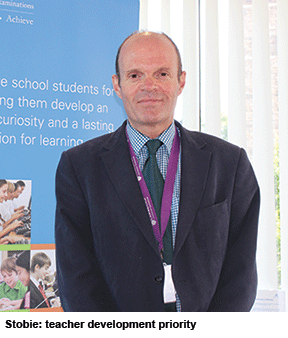
It took an epic struggle in the Supreme Court by the country’s small English-speaking Anglo-Indian community to assert the right of minorities to establish and administer education institutions of their choice decreed as a fundamental right under Article 30 (1) of the Constitution, to establish the Inter-State Board for Anglo-Indian Education. After a brief interregnum it transformed into the Council for the Indian School Certificate Examinations (CISCE, estb.1958), the successor school examination board of UCLES in India.
Currently, CISCE has 2,190 schools countrywide (including almost all former Senior Cambridge schools) affiliated with it. But even so, the right of religious and linguistic minorities to run English-medium schools in free India would not have become a ground reality but for widespread anti-Hindi riots which broke out in the non-Hindi speaking states of south India in the mid-1960s. Meanwhile, UCLES/Senior Cambridge made a quiet exit from Indian education.
Since then, only after substantial liberalisation and deregulation of the Indian economy from Soviet-inspired licence-permit-quota raj and after the IBO-affiliated Mahindra United World College of India, Pune was established in 1997 following a 15-year struggle in the corridors of power in New Delhi, have greenfield schools affiliated with offshore examination boards been permitted to admit students in India.
Meanwhile back in the UK, in 1998, the schools examination board of Cambridge University was restructured. Three subsidiary exam boards were created within UCLES (subsequently renamed Cambridge Assessment in 2005) — CIE for international school examinations and certification; OCR, an examination and certification board for domestic schools and students, and Cambridge English Language Assessment which conducts the global IELTS (International English Language Testing System).
After liberalisation and particularly in the new millennium, CIE has made a quiet re-entry into India and within 15 years has signed up 389 primary-secondaries as affiliated institutions. An impressive achievement, but not as impressive as in neighbouring Pakistan which hosts 600 CIE-affiliated schools.
Clearly with its 158 years’ experience of international syllabus formulation and design for primary-secondaries, its institutional memory and linkages in India, its close relationship with the Cambridge University Press (the highly respected textbooks publisher) and with the top-ranked Cambridge University, in the race for signing up high-end schools as affiliates in India, CIE has the inside track. And the affiliation fees (Rs.4 lakh for primaries and Rs.10 lakh for full school (classes V-XII) at current rates of exchange) demanded by CIE are substantially less than fees charged by the Geneva-based IBO (Rs.30 lakh).
Schools signing up with CIE receive the board’s deeply researched syllabuses, branding rights, standardised assessment services and supplementary resources including free-of-charge online teacher training (dedicated teacher training and workshop participation is chargeable), and opportunity to participate in teacher and student exchange programmes with CIE schools in 160 countries.
Although for managements of primary-secondaries intent upon delivering real as opposed to ritual learning outcomes to students, the prime attractions of CIE affiliation are the board’s contemporary, innovative syllabuses, standardised assessment system and globally valued certification, the supplementary resources and services provided by this vintage school examinations board are perhaps equally valuable. Among them: teacher training and professional development, advising affiliated schools to formulate their institutional philosophy, and curriculum and pedagogy development aid and advice.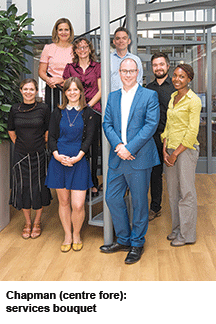
"Continuous delivery of teacher training and professional development programmes to our schools is a high priority focus area for CIE. During the past year, we have held 1,300 teacher education and development events around the world and 60 face-to-face training workshops for affiliated schools in India. Over the next 12 months, we intend to establish more Professional Development Qualification centres in which our master trainers will provide training and professional development services not only to teachers of CIE schools, but to all teachers interested in enhancing their skills. This initiative is inspired by our belief that the CIE syllabus must be culturally enriched and taught differently in every country, and that teachers need to practice active learning which challenges students to strive to achieve their best,” says Dr. Tristian Stobie, the Cambridge-based director of education at CIE. An economics, political science and education alumnus of Edinburgh University, Stobie acquired a wealth of teaching and admin experience in New Zealand, Lesotho, and the UK and served with the Geneva-based IBO for 25 years prior to signing up with CIE in 2011.
Teacher training and development which is of vital importance to translate syllabuses into meaningful curriculums and classroom pedagogies, is only one of the services and resources the CIE management provides affiliated schools. According to Guy Chapman, a Spanish and French graduate of Oxford University and former advertising professional who served with the British Council (2003-14) in Kazakhstan, Jordan, Lebanon and Iraq and is currently CIE’s deputy director of marketing, communications and customer relationships, the board provides a wealth of support and resources for teachers in affiliated schools. The package includes online supplementary resources for teachers, aid and advice to schools to qualify for affiliation, guidance for the registration process, convening online discussion forums and offline workshops and a “unique consultation process” for syllabus development and examinations scheduling. The latter has resulted in the introduction of the March examination series in India for IGCSE exams last year and the A level exams in 2016.
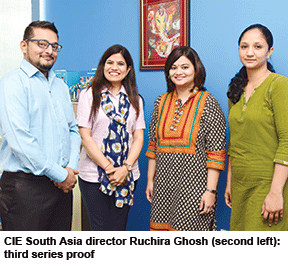 “With the middle class growing in developing countries around the world, the demand for bilingual including English language education and well-designed syllabuses is rising exponentially. This year, the number of entries for CIE exams has risen by 10 percent worldwide and 15 percent in India, and we expect the number of entries worldwide to grow by 40 percent over the next five years. In CIE, we are committed to supporting our schools. During the past year, our support personnel made hundreds of visits to affiliated schools for teacher development workshops, seminars and discussion forums,” says Chapman.
“With the middle class growing in developing countries around the world, the demand for bilingual including English language education and well-designed syllabuses is rising exponentially. This year, the number of entries for CIE exams has risen by 10 percent worldwide and 15 percent in India, and we expect the number of entries worldwide to grow by 40 percent over the next five years. In CIE, we are committed to supporting our schools. During the past year, our support personnel made hundreds of visits to affiliated schools for teacher development workshops, seminars and discussion forums,” says Chapman.
After the IMF/World Bank forced liberalisation of the Indian economy in 1991 when it became embarrassingly apparent that India’s education system lagged way behind developed OECD countries, and was hopelessly trailing China and South-east Asia in terms of adult literacy and children’s learning outcomes, the neta-babu brotherhood, which had driven Indian education into a dead-end, was compelled to loosen its chokehold on private initiatives in education. The subsequent promotion of a large and growing number of high-end private, including new genre capital-intensive international schools to cater to the demand from the post-liberalisation middle class, has prompted aspirational schools to roll out the red carpet for CIE, which has renewed its India association with vigour and enthusiasm by establishing a South Asia office in Mumbai to market its syllabuses and services in India, Sri Lanka, Bangladesh and Nepal.
“CIE has always been serious about serving the large and growing market for high quality globally accepted K-12 education in India. The special third series of March IGCSE and A level exams we have introduced to synchronise our exams with college admissions for Indian students is proof of our commitment to help schools and students in India to raise teaching-learning standards to international levels. And the response of school managements and parent communities to Cambridge’s well-researched and designed syllabuses and services has been very positive. In 2004, the number of Cambridge-affiliated schools in India was a mere 50. Since then, the number has risen to 250 in 2014 and 389 this year. The feedback from our schools is that they are very satisfied with our syllabuses, teacher development and other support services to enable them to develop excellent curriculums,” says Ruchira Ghosh, regional director (South Asia) who has assembled a ten-member team in Mumbai to market and provide aid and advice to over 500 primary-secondaries affiliated with CIE in South Asia.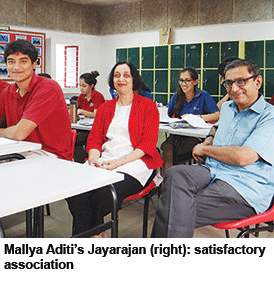
The diligence with which the CIE management has developed the board’s well-structured syllabuses and a full suite of supplementary services, has impressed committed educators in India where education regulatory bodies (UGC, AICTE, CBSE etc) tend to be headed by under-qualified political appointees whose priority is to satisfy brash politicians and overweening generalist bureaucrats, rather than educators and students.
“Mallya Aditi has been affiliated with CIE for over 20 years and we are very satisfied with this association. The board’s syllabuses, especially of social sciences and humanities subjects, are designed to stimulate application of concepts to real life situations, and develop the writing, analytical, discursive and creative skills of students,” says Satish Jayarajan, principal (since 2003) of the Mallya Aditi International School, Bangalore (estb.1984), consistently ranked among the country’s Top 5 co-ed day schools in the annual EducationWorld India School Rankings (2016 rank: #2)
Dr. Vandana Lulla, principal of the Podar International School, Mumbai who has a Ph D in education from Columbia University, is also very pleased that Podar International — ranked #12 countrywide in the international day schools category in EWISR 2016 — was the first school in India’s commercial capital to sign up with CIE in 2003. “Their intelligently designed syllabuses — revised every six years — challenge the cognitive and critical thinking skills of students and enable them to apply knowledge. Moreover, their teacher training and support services are excellent and much more affordable than of other offshore examination boards,” says Lulla.
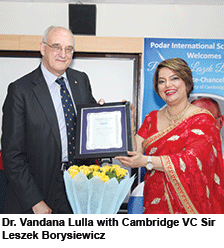 However, it’s not all petals and encomiums for CIE across the widely dispersed and heterogeneous Indian school education landscape. Robbi Subba, the knowledgeable founder-director of the Himali Boarding School, Kurseong (estb.1978), ranked #1 co-ed boarding school in West Bengal in EWISR 2016, which signed up with CIE almost a decade ago, is less than satisfied with the UK-based exam board’s low-profile in the seven sister states of north-east India. “The overwhelming majority of parents in the north-east don’t know anything about CIE, and their online support services don’t work because of this region’s poor internet connectivity. Even in Kolkata, CIE has a negligible number of affiliated schools. The board needs to step up its brand promotion and service delivery efforts in eastern India and the north-east in particular,” says Subba, a certified CIE master trainer.
However, it’s not all petals and encomiums for CIE across the widely dispersed and heterogeneous Indian school education landscape. Robbi Subba, the knowledgeable founder-director of the Himali Boarding School, Kurseong (estb.1978), ranked #1 co-ed boarding school in West Bengal in EWISR 2016, which signed up with CIE almost a decade ago, is less than satisfied with the UK-based exam board’s low-profile in the seven sister states of north-east India. “The overwhelming majority of parents in the north-east don’t know anything about CIE, and their online support services don’t work because of this region’s poor internet connectivity. Even in Kolkata, CIE has a negligible number of affiliated schools. The board needs to step up its brand promotion and service delivery efforts in eastern India and the north-east in particular,” says Subba, a certified CIE master trainer.
Be that as it may, there’s no doubt that CIE’s re-entry into India’s primary-secondary education sector is a positive development. The poor scores recorded by sample batches of students selected from a cross-section of India’s secondary schools in PISA (Programme for International Student Assessment) 2010 (in which the first ever batch of 15-year-olds from India was ranked 73rd among 74 national teams) and in the National Achievement Survey 2015 conducted by the National Council for Educational Research & Training (see EW June 2016 cover story), as also the Annual Status of Education Reports published by Pratham, which routinely reports declining learning outcomes in rural primaries countrywide, are strong signals that root and branch reform is required in India’s laggard K-12 education system, especially in the areas of syllabus formulation, design and teacher training and development.
Against this dismal backdrop, CIE’s entry into this country’s primary-secondary education space and particularly the intensifying competition between this UK-based exams board and the Geneva-based IBO is certain to prompt all 34 school examination boards countrywide, including the pan-India CISCE and CBSE, to repair if not overhaul their archaic syllabuses, prescribed curriculums and teacher training programmes. And the prime beneficiaries of this development will be the 230 million children in India’s primary and secondary schools at the start of every academic year, struggling within a fast-obsolescing education system.